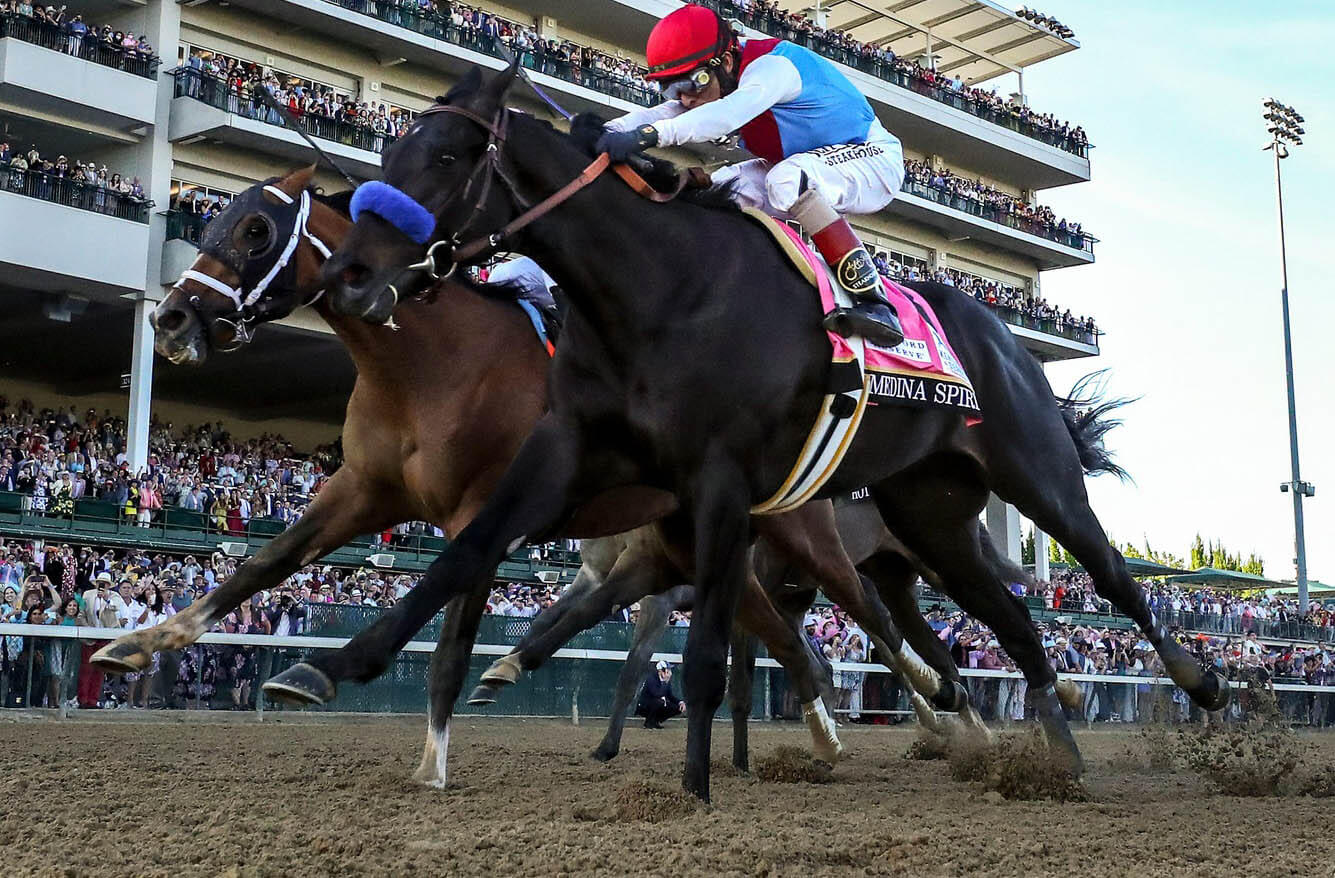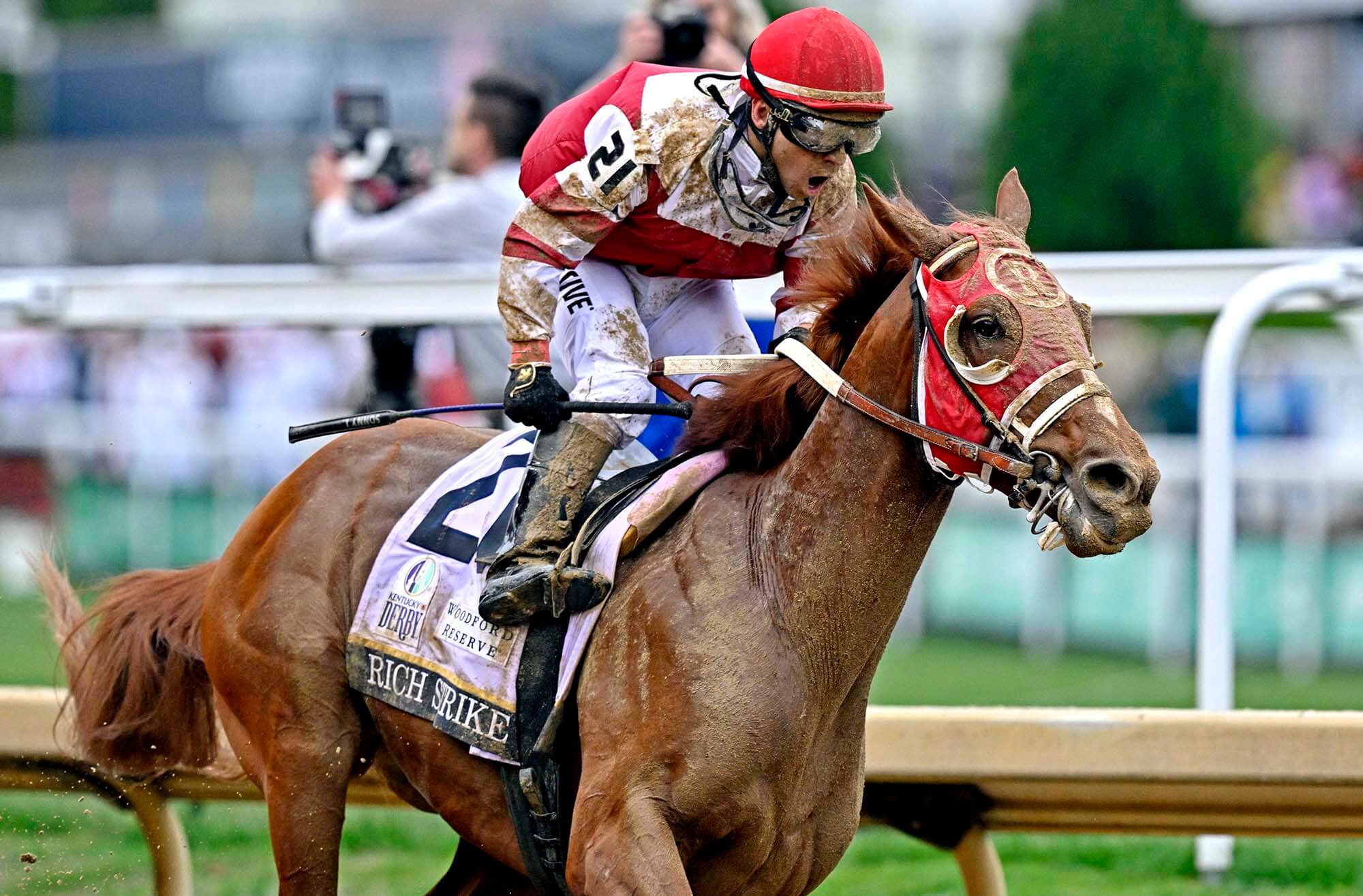Beginners guide to betting on horses
Jump to:
Bet typesExotic wagersHow to read oddsTips
The Kentucky Derby opens the Triple Crown in May and is the most popular horse racing event in the world and draws a ton of betting action on its horse racing odds.
Monique Vág
Last Updated: Apr 24, 2023 1:00 PM ETRead Time: 6 min
Photo By - USA TODAY Sports
Horse racing is one of the oldest and most popular betting markets around.
And even though the
Triple Crown events — the
Kentucky Derby,
Preakness Stakes, and
Belmont Stakes — get all the attention in the spring, races are being held nearly every day of the year at tracks around the globe.
Picking the winner of a race is the most basic of horse racing bets, however, there’s a large menu of options for horse racing odds to choose from.
Types of horse racing bets
There are two different categories of horse racing bets you can place: straight wagers and exotic wagers.
Straight wagers
When making a straight horse racing bet, the focus is on the performance of a single horse in a single race. There are four versions of straight wagers:
Win
This wager requires your favorite horse to finish first and win the race. That’s the only way your ticket is a winner. A win bet carries a higher risk than other straight wagers and therefore pays out more.
Place
Betting on a horse to finish first or second. The payout on a place bet is less than a win bet (a smaller risk due to two possible payout results), but if your horse finishes first or second, you collect.
Show
Betting on a horse to finish either first, second or third – also known as “hit the board”. Due to the nature of this bet, you have a better chance at winning because you have three options (inside the Top 3), but the payout is substantially less than a bet to win or place.
Across the board
You're also able to combine all three of these straight wagers by doing an across-the-board bet - betting a horse to win, place and show. If the horse wins, you collect all three different payouts. You can also bet a combination of win and place or place and show.
Exotic wagers
Exotic wagers offer the option of tying together the number of horse racing picks from the same race or across various races with one single bet amount.
Exotics have the potential for a much larger payout than straight wagers but have a higher risk due to the numerous results involved. All the picks included in the exotic wager must be correct to be graded a winner.
There are multiple variations of horse racing exotics:
Exacta bet
Betting on the combination of horses that will come in first and second. You can bet it straight or box the selections, which means that as long as the ones you pick finish in the Top 2 – regardless of order – you win the bet. A boxed exacta costs twice as much as a straight exacta because you're paying for the added number of combinations.
Trifecta bet
Trifecta wagers are similar to exacta bets but you're selecting the Top-3 finishers of the race. You can bet it straight, use a trifecta box, or include multiple horses. Of course, the more horses you include on the bet ticket, the larger the risk amount.
Superfecta bet
Predicting the Top-4 finishers of the race. This is a very tricky wager. A lot of tracks or horse racing online allow this wager to be played at a 10 or 20 cent base, which allows you to maximize how many horses you can have without changing the amount wagered. Usually, with exotics, the base is $1 so lowering the base allows for more combinations.
Daily double bet
A daily double wager is betting on the winner of two consecutive races. To win, you must correctly select the winner of both races. This bet is usually available in the first two races on the card or the final two races of the day.
Quinella bet
Similar to the exacta, you're betting on which horses will come first and second but the order in which they finish first and second doesn't matter. However, unlike a box exacta (which requires two bets), a Quinella bet requires only one but normally doesn't pay as well.
Pick 3, 4, 5, 6 bet
You must select the winner of each race in sequential order. The “pick” number refers to the number of races in the sequence, rather than the order of where they finish. You can bet it straight or like exotic wagers, you can include more horses in each race. But with more horses, the cost of the bet ticket drastically increases.
How to read horse racing odds
Horse racing odds are most often displayed in fractional odds. They're essentially simple math: dividing one number by another and then taking that sum and multiplying it by your bet amount.
The one key thing when factoring fractional odds is how the numbers are displayed. If the larger number is being divided by the smaller number – ie: 3/1 – then the odds will pay out more than the original bet risked. But if the smaller number is divided by the larger number – ie: 1/3 – then the odds will pay out less than the original bet risked.
For example, odds of 3/1 will pay three times (300 percent) the amount risked, so a bet of $2 would profit $6 if it wins. Odds of 1/3 will pay only 33.33 percent of the amount risked, so a bet of $2 would profit only 67 cents if it should win. Odds of 1/1 will pay the same amount risked, so a bet of $2 would profit $2 if it should win.
Pari-mutuel betting
Pari-mutuel betting in horse racing is the total pool of money wagered on a particular type of bet that is then divided up among the winners after the track deducts its overhead costs and taxes.
Due to horse racing being a pari-mutuel system, there are no fixed odds and odds will change as more bets are placed. You may not be guaranteed a profit on the amount wagered even if your ticket hits, depending on how much of that pool is riding on the same bet.
Once the race is off, you will be able to calculate your potential payout based on the chart below. This lets you know what a $2 bet at those particular odds will pay (including the original $2 wagered).
Horse racing betting sites
Legal online horse racing betting sites fill the void created by sportsbooks for wagering on the races.
Check out our guide that identifies the best
horse racing betting sites in your area.
Horse racing betting tips
Follow the trends and stats
There are so many different trends and tidbits of information, which can prove useful when betting on horse racing odds.
Much like human athletes, some horses excel at particular racetracks, over certain surfaces and distances, or at different times of the year. It's important to read the trends and play into particular strengths of trainers, jockeys, and the equine athletes themselves.
Some trainers flaunt amazing numbers with horses making their debut on the racetrack, some excel with juveniles, and some do better with horses over the turf. You can find some very useful information in the program: everything from horse racing trends to a jockey and trainer's particular ROI when they meet up.
Look for changes in surface or equipment
You will want to keep tabs on notable changes that may help to spark a big effort.
Did a horse seemingly not grip the surface well or put forth an uncharacteristically bad effort? Maybe a change of surface could help. Did the horse drift badly in the deep stretch or get out to a slow start?
Blinkers (used to prevent a horse from seeing to the side) added or removed could help keep a runner's attention down the stretch.
A change in the distance could be very helpful. A horse may have tired late which ended up costing them a better finish, or another horse may have been crying out for more furlongs while making a late closing bid. Pay attention to these changes in distance and try to understand why they may be happening.
A drop-in class could also help yield a big effort, facing weaker competition than in previous races. On the other hand, a horse that has been racing well recently could offer a big price when running against much tougher fields. Although on paper they may appear to be overmatched, a horse entering with confidence or strong current form presents good value.
Manage your bankroll
Although this one often seems self-explanatory, it's one of the trickiest things to master. Don't put all your money on one particular horse to win or spend all of it on a Pick 4 sequence.
Instead, try to diversify your bets and if you don't like the race or don't feel you have a solid read on it, don't bet.
Increase the amount of money you're willing to play based on confidence in your horse racing picks and don't go overboard trying to chase after that life-changing score in the Rainbow Pick 6. If you're betting hoping to yield a profit long term, there's no get-rich-quick solution.
Also, don't let high odds scare you away, and don't be afraid to take a shot. Sometimes all it takes is a little bit of money and a gut feeling to cash big.










